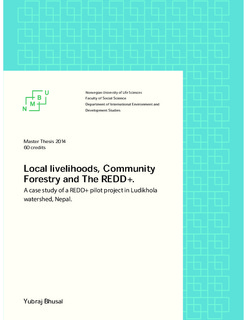| dc.description.abstract | REDD+ mechanism is considered as a critical step towards curbing greenhouse gas emission and also to store carbon in the forest of developing countries. Nepal's community forests are benefiting a large number of local people and sequestering carbon. For the successful implementation of REDD+ activities in community forests, future REDD+ mechanism should be compatible to community forest institutions, able to support local people's livelihoods and reduce carbon emissions. This research analyzes REDD+ mechanism and local livelihoods in the context of community forestry by taking a case of Ludikhola watershed, a REDD+ pilot project area, Nepal. Both qualitative and quantitative research methods were employed including household surveys, interviews with key persons, focus group discussions and literature review.
The study found that people in the study area were mostly poor with per capita income less than US$ 2.2 a day. Various socio-economic characteristics such as land holdings, annual incomes, and education levels were significantly different based on ethnicity, well beings and locations. Households' diversification index of income showed that a majority of the households had diverse sources of incomes. Compared to less poor households, the poor depend more on agriculture and off-farm activities. Whereas more wealthy households have higher incomes from remittances and non-farm activities. A few households were found to be involved in the commercial farming due to limited productive farming lands and irrigation facilities. Though households' need of the forest products was not entirely fulfilled by the community forest, they depend on the community forest for firewood , timber and leaf litter. Carbon stock was found to be gradually increasing every year as a result of various forest conservation measures implemented by forest users. The pilot project distributed total amount of US$ 79,866.00 to three studied CFUGs with strict criteria of utilization of the funds benefiting mostly poor and dalit households.
More than 85% of the HHs expressed that they have a fear of unequal distribution of payments, more conflicts in the village and more corruption under the future REDD+ activities. Contestations between CFUGs and forest officials was observed regarding carbon rights as both forest users and the government are integral actors of future REDD+ mechanism. Involvement of local people in the community based MRV mechanism looked cost efficient; however, to be continued in future REDD+ mechanism, performance based payments to forest users must surpass the associated costs of carbon management, provide additional benefits to local people for protecting forests and implement activities to reduce forest dependency. Considering future REDD+ mechanism, a few limitations were observed in terms of the 'design principles' such as congruence, monitoring resources and conflict resolution. Those limitations are needed to be resolved in order to sustainably implement REDD+ activities in the community forests of Nepal. | nb_NO |
